�
On
Writing
Well
30th Anniversary Edition
THE CLASSIC GUIDE TO
WRITING NONFICTION
William Zinsser
CONTENTS
PART I Principles
COVER
TITLE PAGE
INTRODUCTION
1 The Transaction
2 Simplicity
3 Clutter
4 Style
5 The Audience
6 Words
7 Usage
8 Unity
9 The Lead and the Ending
10 Bits & Pieces
PART II Methods
PART III Forms
11 Nonfiction as Literature
12 Writing About People: The Interview
13 Writing About Places: The Travel Article
14 Writing About Yourself: The Memoir
15 Science and Technology
16 Business Writing: Writing in Your Job
17 Sports
18 Writing About the Arts: Critics and Columnists
19 Humor
20 The Sound of Your Voice
PART IV Attitudes
�
21 Enjoyment, Fear and Confidence
22 The Tyranny of the Final Product
23 A Writer’s Decisions
24 Writing Family History and Memoir
25 Write as Well as You Can
SOURCES
INDEX
ABOUT THE AUTHOR
OTHER WORKS
COPYRIGHT
ABOUT THE PUBLISHER
�
INTRODUCTION
One of the pictures hanging in my office in mid-Manhattan is a photograph of the writer
E. B. White. It was taken by Jill Krementz when White was 77 years old, at his home in
North Brooklin, Maine. A white-haired man is sitting on a plain wooden bench at a plain
wooden table—three boards nailed to four legs—in a small boathouse. The window is
open to a view across the water. White is typing on a manual typewriter, and the only
other objects are an ashtray and a nail keg. The keg, I don’t have to be told, is his
wastebasket.
Many people from many corners of my life—writers and aspiring writers, students and
former students—have seen that picture. They come to talk through a writing problem or
to catch me up on their lives. But usually it doesn’t take more than a few minutes for their
eye to be drawn to the old man sitting at the typewriter. What gets their attention is the
simplicity of the process. White has everything he needs: a writing implement, a piece of
paper, and a receptacle for all the sentences that didn’t come out the way he wanted them
to.
Since then writing has gone electronic. Computers have replaced the typewriter, the
delete key has replaced the wastebasket, and various other keys insert, move and rearrange
whole chunks of text. But nothing has replaced the writer. He or she is still stuck with the
same old job of saying something that other people will want to read. That’s the point of
the photograph, and it’s still the point—30 years later—of this book.
I first wrote On Writing Well in an outbuilding in Connecticut that was as small and as
crude as White’s boathouse. My tools were a dangling lightbulb, an Underwood standard
typewriter, a ream of yellow copy paper and a wire wastebasket. I had then been teaching
my nonfiction writing course at Yale for five years, and I wanted to use the summer of
1975 to try to put the course into a book.
E. B. White, as it happened, was very much on my mind. I had long considered him
my model as a writer. His was the seemingly effortless style—achieved, I knew, with great
effort—that I wanted to emulate, and whenever I began a new project I would first read
some White to get his cadences into my ear. But now I also had a pedagogical interest:
White was the reigning champ of the arena I was trying to enter. The Elements of Style, his
updating of the book that had most influenced him, written in 1919 by his English
professor at Cornell, William Strunk Jr., was the dominant how-to manual for writers.
Tough competition.
Instead of competing with the Strunk & White book I decided to complement it. The
Elements of Style was a book of pointers and admonitions: do this, don’t do that. What it
didn’t address was how to apply those principles to the various forms that nonfiction
writing and journalism can take. That’s what I taught in my course, and it’s what I would
teach in my book: how to write about people and places, science and technology, history
and medicine, business and education, sports and the arts and everything else under the
sun that’s waiting to be written about.
�
So On Writing Well was born, in 1976, and it’s now in its third generation of readers,
its sales well over a million. Today I often meet young newspaper reporters who were
given the book by the editor who hired them, just as those editors were first given the
book by the editor who hired them. I also often meet gray-haired matrons who remember
being assigned the book in college and not finding it the horrible medicine they expected.
Sometimes they bring that early edition for me to sign, its sentences highlighted in yellow.
They apologize for the mess. I love the mess.
As America has steadily changed in 30 years, so has the book. I’ve revised it six times
to keep pace with new social trends (more interest in memoir, business, science and
sports), new literary trends (more women writing nonfiction), new demographic patterns
(more writers from other cultural traditions), new technologies (the computer) and new
words and usages. I’ve also incorporated lessons I learned by continuing to wrestle with
the craft myself, writing books on subjects I hadn’t tried before: baseball and music and
American history. My purpose is to make myself and my experience available. If readers
connect with my book it’s because they don’t think they’re hearing from an English
professor. They’re hearing from a working writer.
My concerns as a teacher have also shifted. I’m more interested in the intangibles that
produce good writing—confidence, enjoyment, intention, integrity—and I’ve written new
chapters on those values. Since the 1990s I’ve also taught an adult course on memoir and
family history at the New School. My students are men and women who want to use
writing to try to understand who they are and what heritage they were born into. Year after
year their stories take me deeply into their lives and into their yearning to leave a record of
what they have done and thought and felt. Half the people in America, it seems, are
writing a memoir.
The bad news is that most of them are paralyzed by the size of the task. How can they
even begin to impose a coherent shape on the past—that vast sprawl of half-remembered
people and events and emotions? Many are near despair. To offer some help and comfort I
wrote a book in 2004 called Writing About Your Life. It’s a memoir of various events in
my own life, but it’s also a teaching book: along the way I explain the writing decisions I
made. They are the same decisions that confront every writer going in search of his or her
past: matters of selection, reduction, organization and tone. Now, for this seventh edition,
I’ve put the lessons I learned into a new chapter called “Writing Family History and
Memoir.”
When I first wrote On Writing Well, the readers I had in mind were a small segment of
the population: students, writers, editors, teachers and people who wanted to learn how to
write. I had no inkling of the electronic marvels that would soon revolutionize the act of
writing. First came the word processor, in the 1980s, which made the computer an
everyday tool for people who had never thought of themselves as writers. Then came the
Internet and e-mail, in the 1990s, which continued the revolution. Today everybody in the
world is writing to everybody else, making instant contact across every border and across
every time zone. Bloggers are saturating the globe.
On one level the new torrent is good news. Any invention that reduces the fear of
�
writing is up there with air-conditioning and the lightbulb. But, as always, there’s a catch.
Nobody told all the new computer writers that the essence of writing is rewriting. Just
because they’re writing fluently doesn’t mean they’re writing well.
That condition was first revealed with the arrival of the word processor. Two opposite
things happened: good writers got better and bad writers got worse. Good writers
welcomed the gift of being able to fuss endlessly with their sentences—pruning and
revising and reshaping—without the drudgery of retyping. Bad writers became even more
verbose because writing was suddenly so easy and their sentences looked so pretty on the
screen. How could such beautiful sentences not be perfect?
E-mail is an impromptu medium, not conducive to slowing down or looking back. It’s
ideal for the never-ending upkeep of daily life. If the writing is disorderly, no real harm is
done. But e-mail is also where much of the world’s business is now conducted. Millions of
e-mail messages every day give people the information they need to do their job, and a
badly written message can do a lot of damage. So can a badly written Web site. The new
age, for all its electronic wizardry, is still writing-based.
On Writing Well is a craft book, and its principles haven’t changed since it was written
30 years ago. I don’t know what still newer marvels will make writing twice as easy in the
next 30 years. But I do know they won’t make writing twice as good. That will still
require plain old hard thinking—what E. B. White was doing in his boathouse—and the
plain old tools of the English language.
William Zinsser
April 2006
�
PART I
�

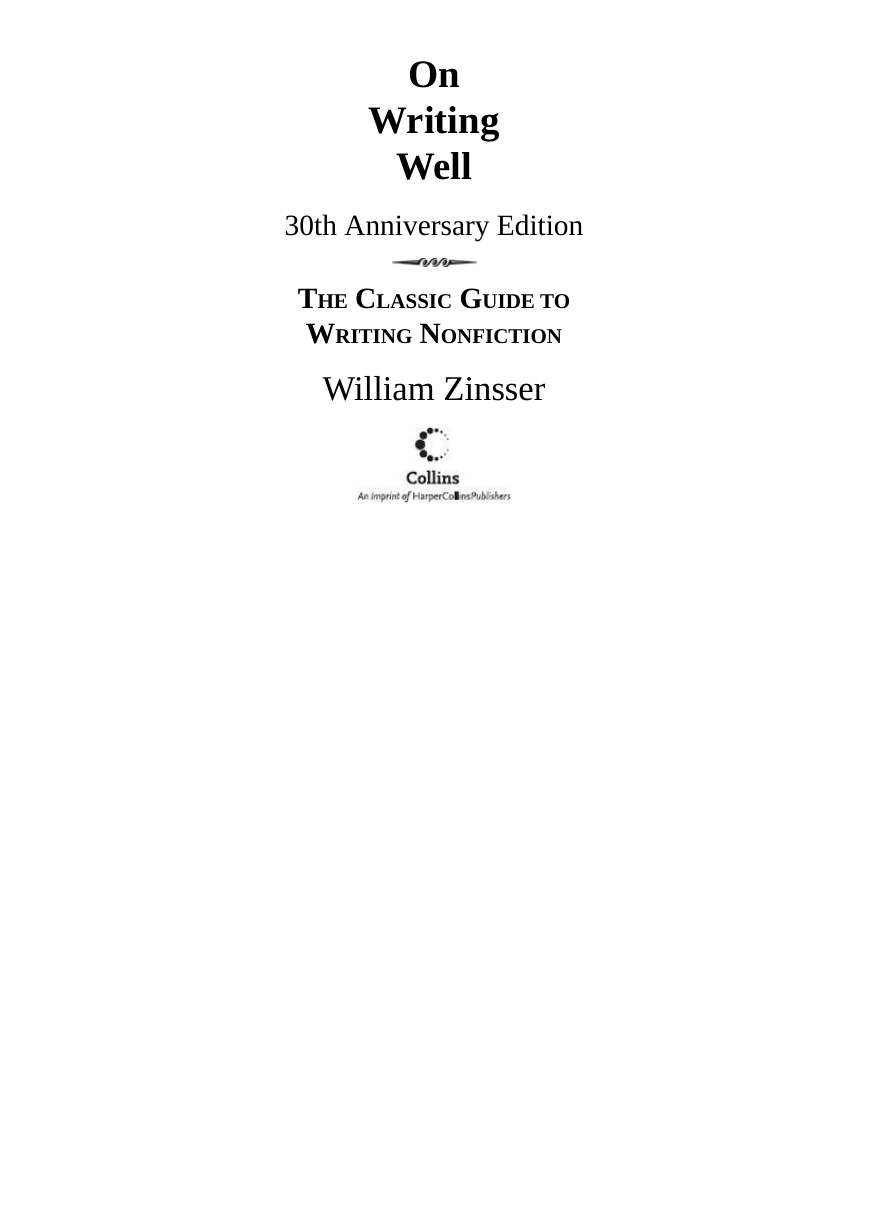

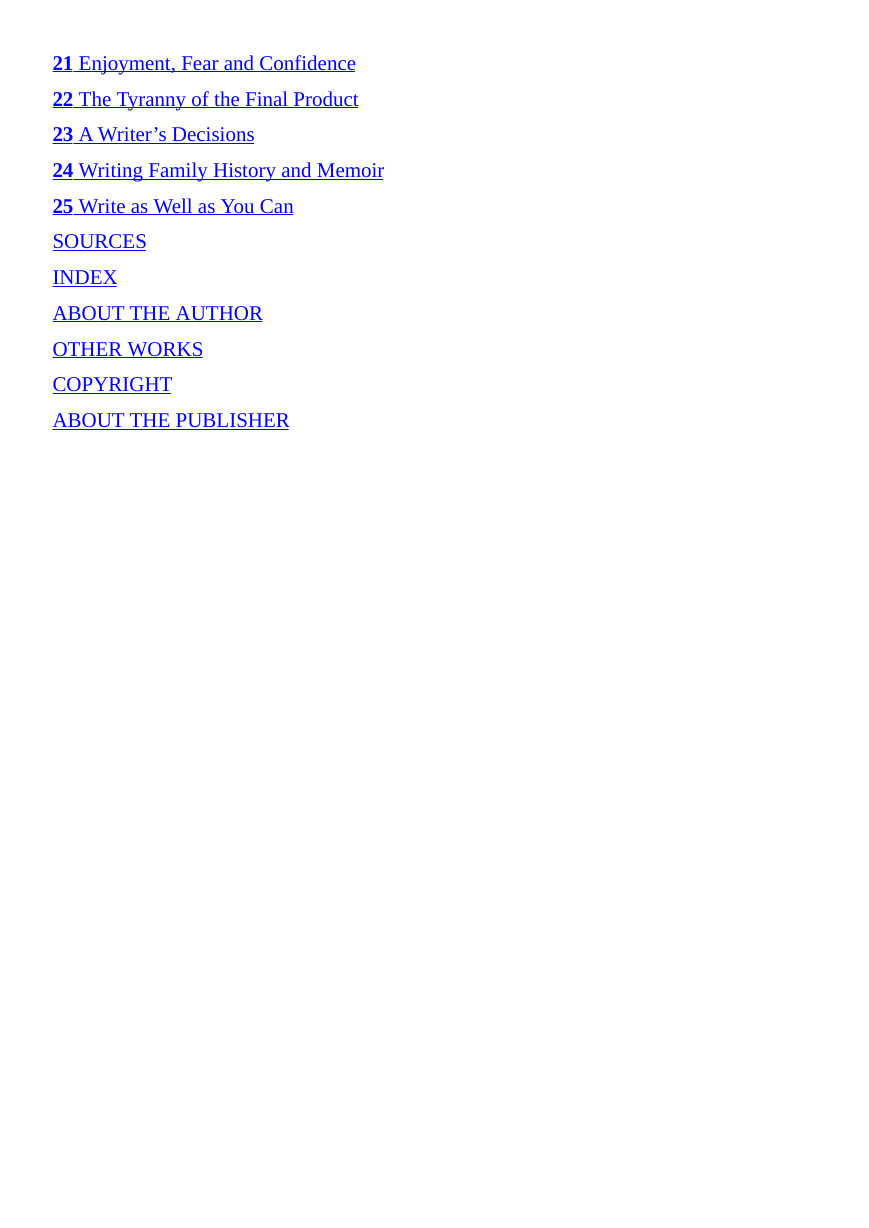
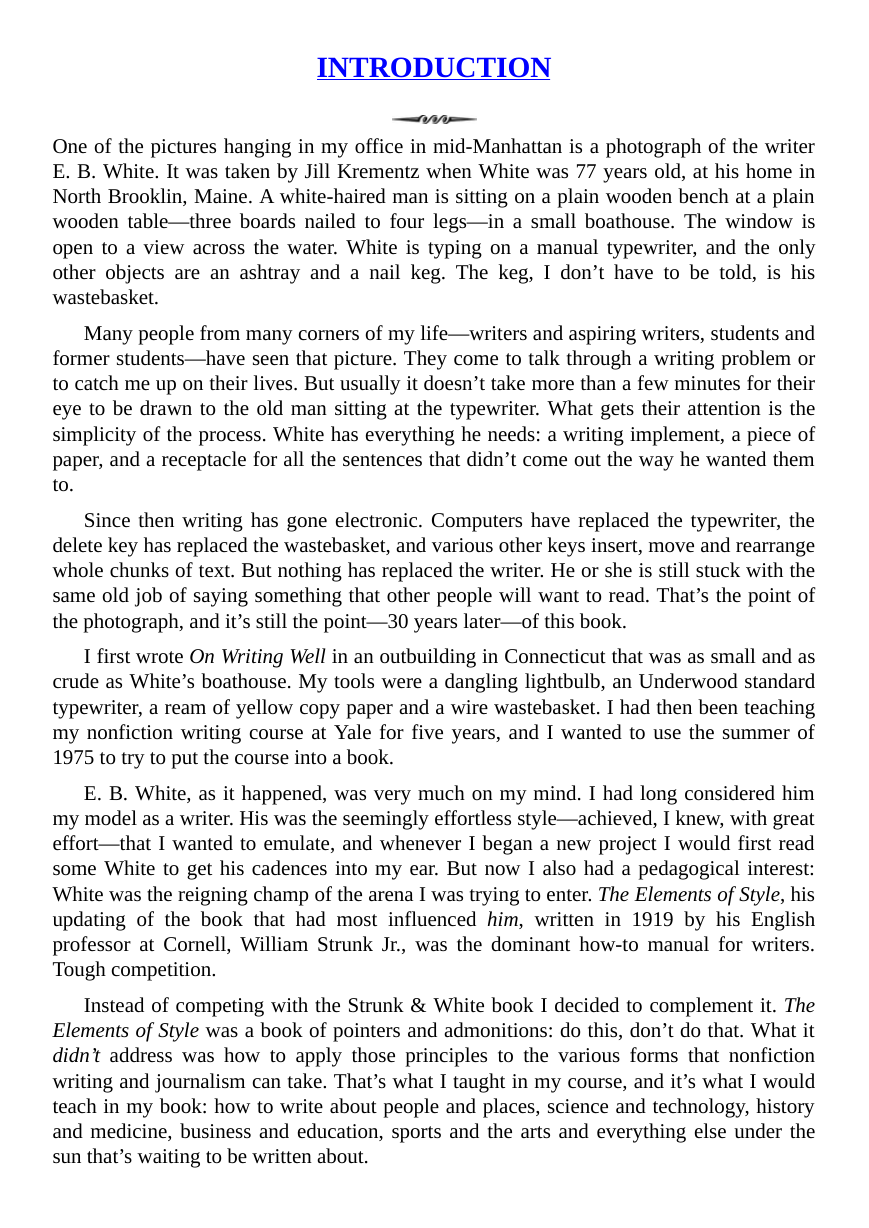
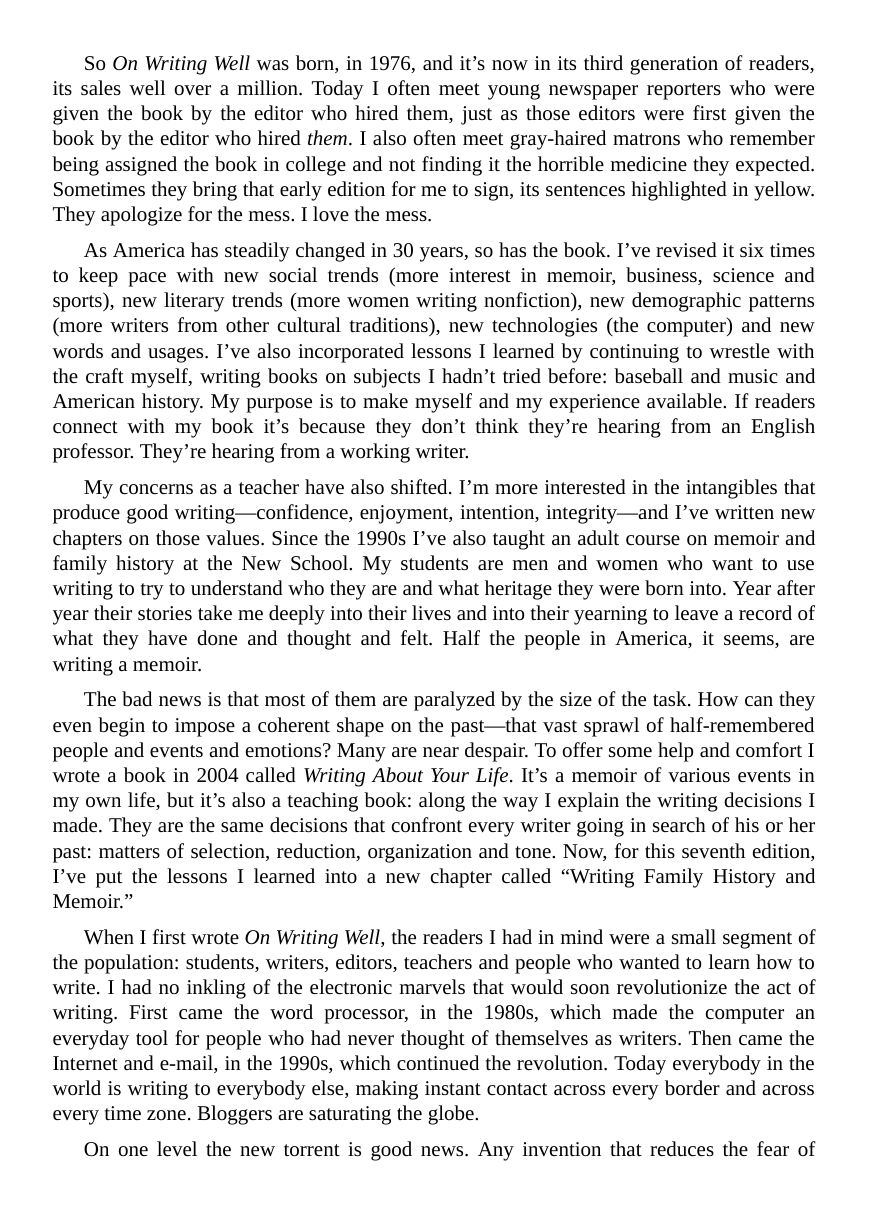
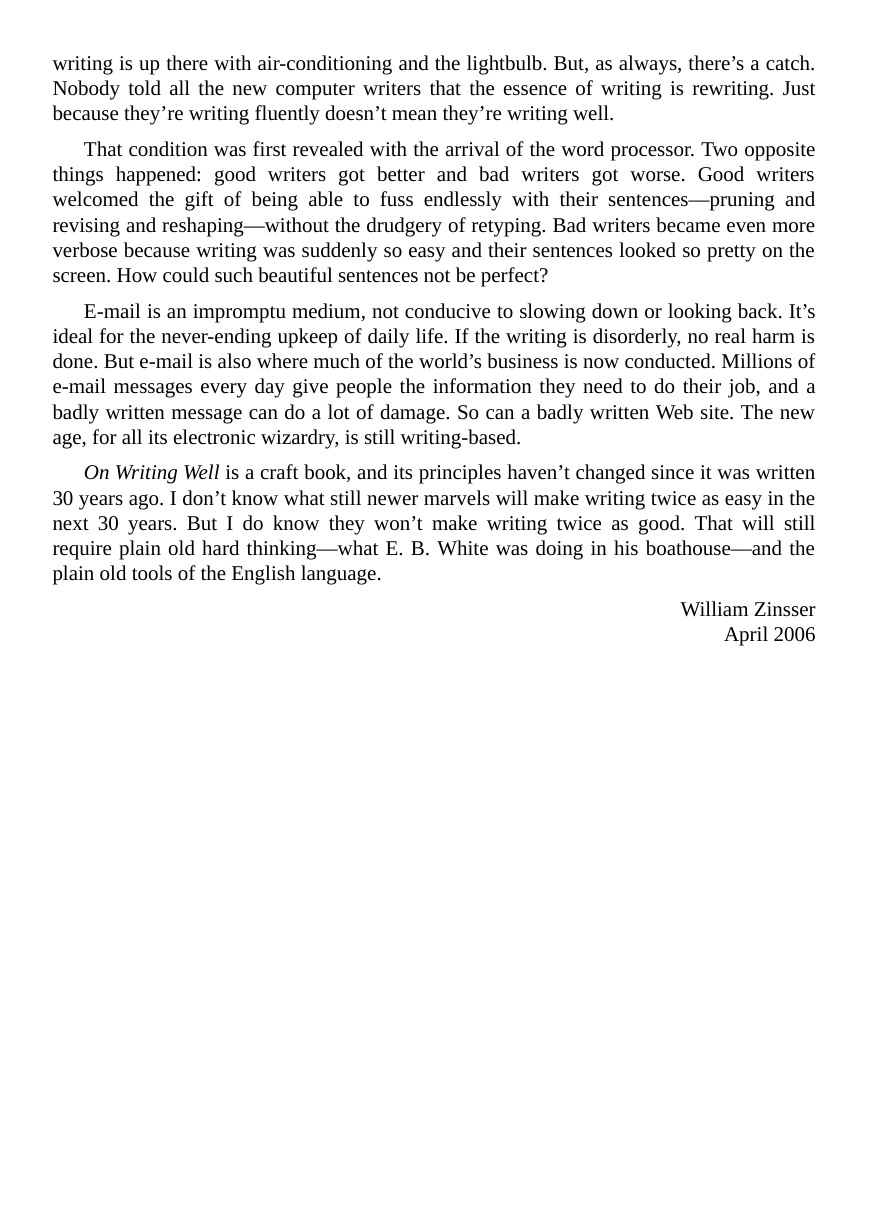









 2023年江西萍乡中考道德与法治真题及答案.doc
2023年江西萍乡中考道德与法治真题及答案.doc 2012年重庆南川中考生物真题及答案.doc
2012年重庆南川中考生物真题及答案.doc 2013年江西师范大学地理学综合及文艺理论基础考研真题.doc
2013年江西师范大学地理学综合及文艺理论基础考研真题.doc 2020年四川甘孜小升初语文真题及答案I卷.doc
2020年四川甘孜小升初语文真题及答案I卷.doc 2020年注册岩土工程师专业基础考试真题及答案.doc
2020年注册岩土工程师专业基础考试真题及答案.doc 2023-2024学年福建省厦门市九年级上学期数学月考试题及答案.doc
2023-2024学年福建省厦门市九年级上学期数学月考试题及答案.doc 2021-2022学年辽宁省沈阳市大东区九年级上学期语文期末试题及答案.doc
2021-2022学年辽宁省沈阳市大东区九年级上学期语文期末试题及答案.doc 2022-2023学年北京东城区初三第一学期物理期末试卷及答案.doc
2022-2023学年北京东城区初三第一学期物理期末试卷及答案.doc 2018上半年江西教师资格初中地理学科知识与教学能力真题及答案.doc
2018上半年江西教师资格初中地理学科知识与教学能力真题及答案.doc 2012年河北国家公务员申论考试真题及答案-省级.doc
2012年河北国家公务员申论考试真题及答案-省级.doc 2020-2021学年江苏省扬州市江都区邵樊片九年级上学期数学第一次质量检测试题及答案.doc
2020-2021学年江苏省扬州市江都区邵樊片九年级上学期数学第一次质量检测试题及答案.doc 2022下半年黑龙江教师资格证中学综合素质真题及答案.doc
2022下半年黑龙江教师资格证中学综合素质真题及答案.doc